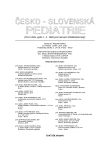Prenatal Exposure to Cigarette Smoke and Behaviour of Children in 18 Months of Age. Results of ELSPAC Study
Authors:
L. Kukla 1; D. Hrubá 2; M. Tyrlík 3
Authors‘ workplace:
Oddělení preventivní a sociální pediatrie Ústavu sociálního lékařství a veřejného zdravotnictví LF MU, Brno
vedoucí prof. MUDr. J. Holčík, DrSc.
1; Ústav preventivního lékařství LF MU, Brno
vedoucí prof. MUDr. Z. Brázdová, DrSc.
2; Psychologický ústav FF MU, Brno
vedoucí prof. PhDr. M. Svoboda, CSc.
3
Published in:
Čes-slov Pediat 2005; 60 (2): 70-76.
Category:
Original Papers
Overview
ELSPAC study, initiated in 1990 and containing a cohort of parents and their children from Brno and Znojmo district, involves a lot of incorporated signs characterising behaviour of 18 months old children who are the subject of interest of anamnesis questionnaire. Authors aimed at the assessment of differences between children with different level of exposure to cigarette smoke.
Prenatal exposure of child to passive smoking was observed by answers to anamnesis questionnaires of mothers in 20th week of pregnancy and after the delivery. They gave there information about their active smoking behaviour. According to these data, only those children who were not exposed to cigarette smoke and whose mothers never smoked, those exposed during the first half of pregnancy and those who were exposed during whole pregnancy were chosen. Differences between both groups of children with different prenatal exposure were compared with the group of non-exposed children and statistically assessed in programme SPSS (tests Pearson chi-square, linear associations, probability relations and ANOVA).
From many characteristics, used for assessment of cognitive and behavioral development of children in 18 months of age, only several differed in children who were exposed to cigarette smoke from those who were not exposed at all: occurence of tics and hitch moves, lack of knowledge of expressions indicating parents, absence of some gestures of non-verbal communication was usually increased in both exposed groups when compared to non-exposed. Quite different view is, however, to be found when we assessed characteristics of temperament: in case of those which showed significant differences, children exposed during the first half of pregnancy were rather shy, less temperament, while children who were exposed during whole course of pregnancy, were more courageous and responsive.
Different epidemiologic studies show proofs of the fact that prenatal and postnatal exposure to cigarette smoke cause damage to behaviour and mental capacity. The children in pre-school, school and adolescent age are usually observed from this viewpoint. In ESLPAC study, the differences between mental development of children non-exposed and exposed in prenatal period to cigarette smoke were found already in 18 months. The set will be analysed in similar way also in following age periods.
Key words:
behaviour of children, prenatal exposure to cigarette smoke, passive smoking
Labels
Neonatology Paediatrics General practitioner for children and adolescentsArticle was published in
Czech-Slovak Pediatrics

2005 Issue 2
Most read in this issue
- Mannose-binding Lectin Deficiency
- Diarrhea Diseases in Hospitalized Children up to 5 Years of Age
- Non-drug Poisoning in Children Hospitalized in Children Faculty Hospital in Bratislava in the Years 1996–2000
- Prenatal Exposure to Cigarette Smoke and Behaviour of Children in 18 Months of Age. Results of ELSPAC Study
